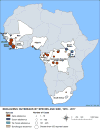Considerations for use of Ebola vaccine during an emergency response
- PMID: 28890191
- PMCID: PMC5842136
- DOI: 10.1016/j.vaccine.2017.08.058
Considerations for use of Ebola vaccine during an emergency response
Abstract
Vaccination against Ebola virus disease is a tool that may limit disease transmission and deaths in future outbreaks, integrated within traditional Ebola outbreak prevention and control measures. Although a licensed Ebolavirus vaccine (EV) is not yet available, the 2014-2016 West African Ebola outbreak has accelerated EV clinical trials and given public health authorities in Guinea, Liberia, and Sierra Leone experience with implementation of emergency ring vaccination. As evidence supporting the use of EV during an outbreak response has become available, public health authorities in at-risk countries are considering how to integrate EV into future emergency Ebola responses and for prevention in high-risk groups, such as healthcare workers and frontline workers (HCW/FLWs), even before an EV is licensed. This review provides an overview of Ebola epidemiology, immunology, and evidence to inform regional and country-level decisions regarding EV delivery during an emergency response and to at-risk populations before a licensed vaccine is available and beyond. Countries or regions planning to use EV will need to assess factors such as the likelihood of a future Ebolavirus outbreak, the most likely species to cause an outbreak, the availability of a safe and effective EV (unlicensed or licensed) for the affected population, capacity to implement Ebola vaccination in conjunction with standard Ebola outbreak control measures, and availability of minimum essential resources and regulatory requirements to implement emergency Ebola vaccination. Potential emergency vaccination strategies for consideration include ring or geographically targeted community vaccination, HCW/FLW vaccination, and mass vaccination. The development of guidelines and protocols for Ebola vaccination will help ensure that activities are standardized, evidence-based, and well-coordinated with overall Ebola outbreak response efforts in the future.
Keywords: Ebola infection; Ebola virus vaccines; Emergencies; Outbreaks; Strategic planning; Vaccination.
Published by Elsevier Ltd.
Conflict of interest statement
All authors report no conflicts of interest. No financial support has been provided for this work.
Figures
References
-
- Team WER. After Ebola in West Africa — unpredictable risks, preventable epidemics. N Engl J Med. 2016;375:587–96. - PubMed
-
- Kerstiens B, Matthys F. Interventions to control virus transmission during an outbreak of Ebola hemorrhagic fever: experience from Kikwit, Democratic Republic of the Congo, 1995. J Infect Dis. 1999;179(Suppl 1):S263–7. - PubMed
Publication types
MeSH terms
Substances
Grants and funding
LinkOut - more resources
Full Text Sources
Other Literature Sources
Medical
Research Materials


